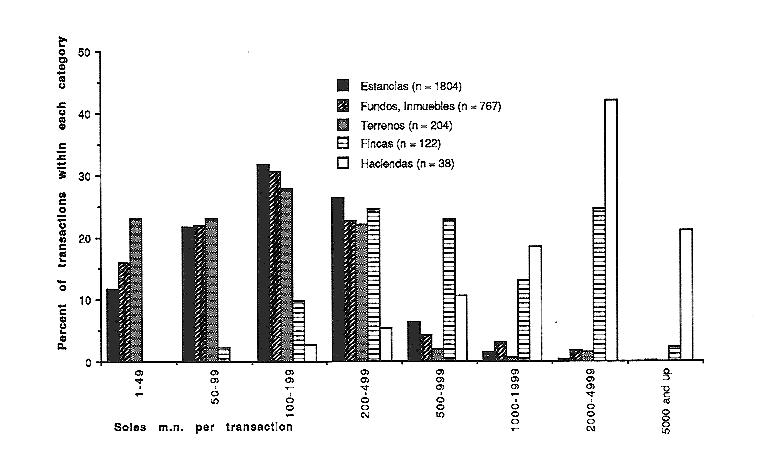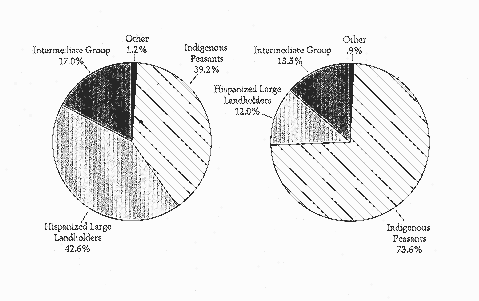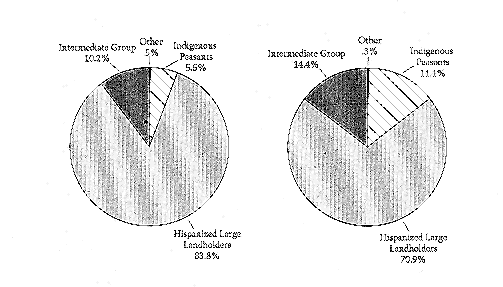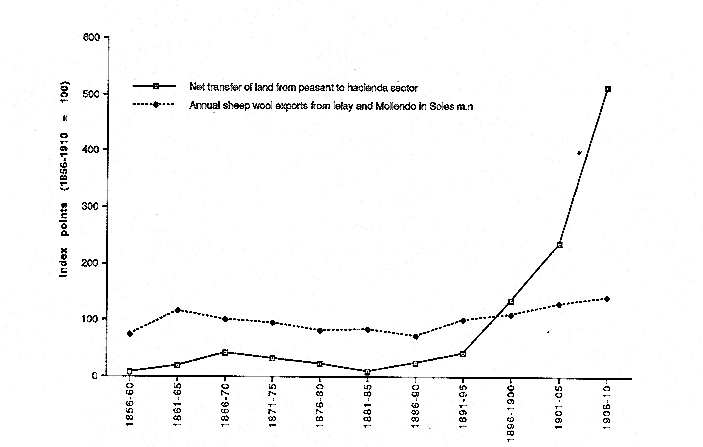Hacienda Expansion
The enormous upsurge of sales constituted the single most important factor influencing the provincial landholding pattern between the 1850s and 1920. Sales of rural landholdings represented the overwhelming majority of contracts recorded by notaries. Their annual number and total value grew from a trickle during the 1850s to an avalanche during the first and second decades of this century.[4] Nearly three-fourths of all sales contracts concluded between 1851 and 1920 were transacted during the last two decades of that period (table 6.1).
This growth of land sales did not proceed in a linear fashion. A first cycle of sales activity reached a peak in 1867 with forty-seven sales contracts evaluated at 35,549 soles m.n.; then their frequency and value declined until about the early 1880s. Only after the end of the War of the Pacific did a recovery begin, and during the early and mid-1890s a level close to the previous peak year of 1867 was reached. A quantitative leap occurred in 1898–99, when within two years the frequency of sales roughly tripled, accompanied by a smaller increase in total value. After 1904 the frequency of sales climbed again to reach 297 sales during 1908, five times more than in the peak year of 1867 during the first cycle. Between 1908 and 1913 the number and value of land transactions reached their peak for the whole period under consideration. In 1914 there followed a brief but sharp slump.
| ||||||||||||||||||||||||||||||||||||||||||||||||||||||||||||||||||||||||
The recovery during the remainder of the decade failed to bring back the frantic rhythm of sales of the prewar years.[5]
A breakdown of all sales according to price allows a clearer understanding of the types of land property changing hands in Azángaro. In over 88 percent of all sales the price lay below 500 soles m.n., and for nearly two-thirds of all cases the price was below 200 soles m.n. In contrast, only 2.9 percent of all priced transactions concerned pieces of land for which a buyer paid 2,000 soles m.n. or more. But how much land could one buy for 200, 500, or 2,000 soles m.n.? There was no easily discernible correlation between the price of land and its size. Beyond factors such as quality and location of the land, the social positions of buyer and seller often influenced price. Powerful hacendados might force a peasants dependent on them for credit and work to sell their ancestral estancia for a price much below its "market value."[6]
If we differentiate sales contracts according to property categories, the preponderance of the estancia is overwhelming. But what did contemporaries understand by estancia ? During the colonial period the term had referred to livestock ranches.[7] For some areas of Spanish America, notably Argentina, estanica even today refers to sizable livestock estates. In the altiplano, however, it ceased to have that meaning by the mid-nineteenth century. Just as David Brading has described for west-central Mexico, the term hacienda began to be used for a particular type of landholding in the
altiplano only during the eighteenth century. It took one hundred years, from the mid-eighteenth to the mid-nineteenth century, for it to replace the term estancia in the semantic field of "livestock estate operating with semi-servile labor."[8] By the 1850s such properties were usually labeled haciendas or fincas , but on occasion estancia was still used with this meaning.[9] In 1849 the Puneño Juan Bustamante, while speaking of the region's "haciendas" still referred to their owners as "estancieros," a term soon to be supplanted by "hacendado."[10]
After the 1860s the term estancia was not used any more when speaking about livestock estates in the Peruvian altiplano. In its new semantic field it referred to the Indian peasant's rural "farm," with its adobe huts, a corral enclosed by a stone wall, pastures, and some parcels planted with potatoes, quinua, and other crops. Estancia became equivalent to "agricultural units of family or sub-family size," in recent social science terminology.[11] Writing in 1947, Juan Chávez Molina, the heir to Hacienda Churura, district Putina, flatly affirmed that "the estancia today is a small property."[12] The term had lost the connotation of livestock ranch. In an analysis of Puno's social stratification in 1931–32, Oswaldo Zea asserted that "in the area of crop farming [zona de chacarismo ] small properties are widespread and are called estancias."[13] The predominance of estancias in Azángaro land transactions thus offers a first indication that land of the peasantry formed the lion's share of the rural property passing hands in the province.[14]
Haciendas and fincas together accounted for just over 5 percent of the total number of sales.[15] On average, fewer than three estates were bought and sold each year between the 1850s and 1910. Size was not a sufficient criterion for differentiating fincas and haciendas from lesser landholdings (fig. 6.1). Attempts to rely on quantitative criteria for defining what constitutes a finca or hacienda, such as minimum size, minimum number of livestock, or minimum production of the property, remain unsatisfactory.[16] By these criteria there was considerable overlap between small fincas and peasant estancias.[17] What distinguished the hacienda from peasant estancias or other family smallholdings was its internal social organization: a stable, hierarchically ordered population resided on its land, and its members were "directly tied to the owner or his representative through a number of personal obligations, of both a material and symbolic nature."[18]
Thus, beginning in the 1850s the same paradoxical constellation of continuity and polarity crystallized in the altiplano's land tenure regime that we observed for the region's social structure: on the one hand, a continuous spread in the size of holdings, from large estates to smallholdings; and on the other, a stark juxtaposition between hacienda and Indian
Figure 6.1
Land Sales in Azángaro, by Category of Property and Price Range, 1852–1910
peasant estancia. This dichotomy was based on the necolonial division between hispanized rural elite and an indigenous peasantry, a division more deeply rooted in the perceptions of the two groups than in different rationalities of their economic operations.
Did the accelerating tempo of land transfers alter Azángaro's landholding pattern or merely represent increased exchange of property within the same categories of landholdings and proprietors? To answer this question, we have to differentiate land sales according to the social origin of sellers and buyers. Among the three social categories of the scale, only members of the category of hispanized large landholders appear as net purchasers of rural property in Azángaro. Only for this group do number and value of land purchases exceed sales (fig. 6.2). By value, some 70 percent of all land transfers into the holdings of this group represent land of indigenous peasants; by number, these transfers are nearly 86 percent. The intermediate group of landholders contributed about 27 percent of the value and 13 percent of the number of land parcels purchased by large landholders.
Land purchases by hispanized large landholders were more markedly cyclical than were overall provincial sales transactions. After negligible amounts of land purchases from peasants and members of the intermediate group during the 1850s, hispanized large landholders expanded their landholdings by more than 140 notarized purchases during the 1860s, with transactions peaking in 1867. During the next two quinquennia these purchases steadily declined to a low of 35 transactions for the period 1876–80, roughly 60 percent below the level of 1866–70.
Land purchases from indigenous peasants continued at a low level through the early 1880s and began to pick up again only in the quinquennium 1886–90 (table 6.2). The brief surge of purchases by hispanized large landholders during the early 1880s resulted exclusively from an increase in transactions with persons assigned to the intermediate group. These transactions during the difficult years of the War of the Pacific may point to the problems faced by impoverished owners of marginal fincas. The double crisis of the early 1880s, in which war-related disruptions of livestock production and commercialization of wool were added to the problem of sliding wool prices, perchaps caused some concentration of landholding within the estate sector while expansion of haciendas into peasant land slowed down.[19] On September 10, 1881, for example, the brothers Felipe and Manuel Figueroa Obando sold Finca Antocollo y Antaña in Putina district without livestock capital for 3,600 pesos (2,800 soles m.n.). At least one of the brothers had been in debt for five years; during the war years they apparently saw no way of extricating themselves from this debt other than selling their land.[20] After 1881 the Figureroa Obandos disappeared from the ranks of estate owners in Azángaro.
Figure 6.2A
Social Categories of Sellers in Azángaro Land Sales,
1852–1910; Left: By value of sales. Right: By number of sales.
Sources: REPA and REPP, 1852
The net transfer of land from indigenous peasants to hispanized large landholders (purchases minus sales) accentuates the nadir of the curve for hacienda expansions between 1876 and 1885. For the long run, this measure can best depict the cyclical nature of hacienda formation in parts of Latin America or, as Eric Hobsbawm has put it, how "in the course of post-colonial history haciendas have been formed, expanded, split up and reformed, depending on political change and economic conjuncture."[21] Sales to peasants increased during this decade of severe commercial, fiscal, and political crisis, just when purchases by hispanized large landholders decreased. As in the quarter century after independence, peasants benefited from the crisis of the hispanized landholding elite, at least with regard to retaining their land.[22]
During the early 1890s land purchases by hispanized large landholders recovered, and from the second half of the 1890s onward their purchases grew at such rapid pace that all previous land transactions are dwarfed by comparison. The value of their acquisitions increased by 160 percent from 1891–95 to 1896–1900, followed by a further jump in 1901–5 of over 50
Figure 6.2B
Social Categories of Purchasers in Azángaro Land Sales,
1852–1910. Left: By value of purchases. Right: By number of purchases.
Sources: REPA and REPP, 1852
percent and another rise of 125 percent from the first to the second quinquennium of the present century. The peak of hacienda expansion was reached between 1908 and 1913. During 1908, with a total of 212 purchases, the frenzy of land purchases by hacendados and other members of the provincial elite approached two transactions every three days.[23]
How are we to account for the accelerating rhythm of hacienda expansion between the late 1850s and 1913? Both contemporary observers and modern scholars have pointed to the favorable conditions thought to prevail in southern Peru's wool export trade as the most important incentive for many hispanized large landholders to expand their estates and found new ones.[24] In 1916 José Sebastián Urquiaga—who, through one of Azángaro's most spectacular land-purchasing campaigns, had turned the small maternal finca Sollocota into one of the province's largest estates—explained this context as follows:
About 25 years ago [i.e., 1890–91] the haciendas of the department of Puno passed nearly unnoticed as profitable estates;
| |||||||||||||||||||||||||||||||||||||||||||||||||||||||||||||||||||||||||||||||||||||||||||||||||||||||||||||||||||||||||||||||||||||||||||||||||||||||||||||||||||||||||||||||||||||||||||||||||||||||||||||||||||||||||||||||||||||||||||||||||||||||||||||||||||||||||||||||||
their products, such as livestock, wool, dried meat, cheese, butter, etc., were sold at extremely low prices, less than half of what they are today. And as the price improvement has made itself felt year after year, the interest in acquiring fincas in the interior was awakened. But since the owners with very few exceptions did not sell their estates, people thought of buying estancias from the ayllu Indians.[25]
Land purchases by hacendados followed export market conditions for wool as the single most important product of the altiplano livestock estates closely enough to reflect cyclical swings of wool prices and export volumes (fig. 6.3).[26] The year 1914 confirms the close correlation between trade conditions and land purchases by hispanized large landholders. The brief dislocation of commercial and credit circuits in southern Peru brought on by the outbreak of World War I coincided with a sharp reduction of land acquisitions by hacendados.[27]
But by the late 1910s something had changed. In these years the value of wool exports reached unprecedented heights, and hacendados were more prosperous than ever before. yet, although in 1918 and 1919 they again acquired much more land than they had in the crisis year of 1914, acquisitions from peasants lay considerably below the levels of 1908–13. Just when the wool market reached its peak, the correlation with land acquisitions broke down. One mighty reason discouraged many hacendados from attempting to acquire more peasant lands: the Rumi Maqui Rebellion, which had swept through several livestock districts of Azángaro province since mid-1915, lifted the level of peasant resistance to encroachments on their lands to a level not seen in the altiplano since the late colonial period. Resistance by community peasants against hacendados continued for the rest of the decade, becoming broader and more ideologically charged during the early 1920s.[28] The tide of hacienda expansion thus began to turn even before the wave of prosperity brought on by rising wool exports had crested.
Other authors have explained the drastic and rather sudden increase of land purchases by hispanized landholders since the mid-1890s as the result of political constellations. Karen Spalding suggested that hacendados required strong military backing in order to shift the balance of landholding in their favor. The conditions for extending such military support were created only when the Civilista oligarchy effectively took power in Lima after Piérola's victory over the Cáceres forces in 1895. The growth of altiplano livestock haciendas thus "was primarily the product of the alliance between the serrano [highland] political elite and the nouveaux riches of the coast, who themselves were dependent on their alliance with foreign capital."[29]
Figure 6.3
Annual Averages of Land Transfers to
Hacienda Sector and of Sheep Wool Exports, 1856–1910, in Soles m.n.
There are two serious problems with this thesis. (1) There is no evidence for the development of such a general class alliance between altiplano hacendados and the ruling coastal oligarchy. Azángaro's politically active hacendados were split along party lines, and many of them fought the local and regional representatives of Lima's ruling Civilista party. (2) Under normal circumstances hispanized landholders in the altiplano did not require military or police contingents supplied by the central government to expand their estates onto peasant lands.[30] As early as 1874 Azángaro's subprefect Daniel Rossel y Salas, a native of Putina who later became judge of Puno's Superior Court and, by marriage, co-owner of Hacienda Huasacona in Muñani, had vividly portrayed how the province's large landholders could carry out armed raids totally independent of, and indeed against the will of, the national police.[31]
In 1931 José Frisancho—who was the offspring of a prominent landholding family from the altiplano town of Pucará and whose judicial career took him from the position of prosecutor in Azángaro's Court of First Instance to the presidency of Peru's Supreme Court—presented an argument similar to Spalding's.[32] As he saw it, the centralism of Lima's "pseudo-aristocracy" after 1895 subverted the political and moral fiber of serrano society, making it servile and corrupt.[33] This subversion had a sudden and dramatic impact on landholding in the highlands. Between independence and 1895 the upright, patrician landholders of the sierra were "mere conservers of the colonial haciendas," and "not a single case" existed in which indigenous community lands were incorporated into a latifundium. "After 1895 occurred the rapid transformation of the communities into latifundia, to such a degree that in some provinces the ayllus have disappeared."[34]
In Frisancho's view the new political regime established by Piérola brought a class of persons to the surface of altiplano society who had no scruples about appropriating peasant lands. In reality, however, there was no sudden qualitative break in the relations between hacendados and Indians and, more specifically, in the methods of acquiring peasant lands. The whole panoply of a paternalistic, neocolonial society—from entrapment through debt to legal ruses and sheer force—became gradually entrenched during the decades before 1895.
But Frisancho's analysis contains one important observation: after the end of the War of the Pacific, and increasingly during the 1890s, many newcomers to the altiplano began to form estates from strings of peasant estancias. These new residents were attracted to the economic opportunities linked to the short-lived mining and rubber collection boom in the ceja de la selva of Carabaya and Sandia but also to the growth of commercial
networks in the altiplano. The military campaigns during the War of the Pacific and the subsequent civil war may also have led some soldiers and officers to settle in the altiplano.[35] Among the 436 men entered in Azángaro's electoral register for the year 1897, 96 were born outside the province.[36] The influx of these newcomers during the late 1880s and early 1890s accounts for a good part of the increased land purchases in Azángaro following 1895.
The two decades between Piérola's civil war victory in 1895 and World War I marked the high tide of gamonal power over the Indian peasantry of the altiplano. The consolidation of Peru's oligarchic regime during what has come to be called the Aristocratic Republic set the stage allowing the region's elite of large landholders, traders, and officeholders to take full advantage of the favorable commercial conjuncture that whetted their appetites for pastoral resources and peasant labor. The penetration of a modern network of transportation and communication through the southern sierra, fueled by exaggerated hopes of economic development, and the expansion of the infrastructure and fiscal means of the central state helped to strengthen the altiplano's elite after 1895.
But the path on which this elite had come into being, in an incipient and contradictory fashion between the 1820s and 1850 and in a first moment of ebullient power between the late 1850s and early 1870s, was unique to the south. This newly forming elite was indebted to the central government only through its relative weakness in the southern highlands. The bases of the large landholders' power, independent of any alliance with oligarchic groups on the national level, were their favorable insertion into the expanding commercial circuits centered on Arequipa as well as the consolidation of clientele systems, a process made easier by the commercial expansion. It is true that beginning in the 1890s the provincial elite of the altiplano expected increasing support from the central government to consolidate their gains vis-à-vis the peasantry, both through distribution of funds and offices derived from Lima among their clients and through strengthened police and military contingents in the countryside. Yet the gamonales never saw themselves as junior partners of Lima's oligarchy. They insisted on maintaining independent power in the provinces against what they perceived as the threat of subversive modernization pushed by the central government.



